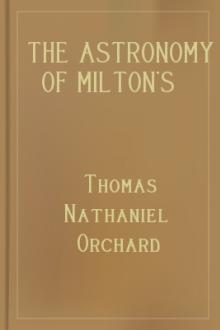The Astronomy of Milton's 'Paradise Lost' by Thomas Nathaniel Orchard (easy books to read in english TXT) 📕

- Author: Thomas Nathaniel Orchard
- Performer: -
Book online «The Astronomy of Milton's 'Paradise Lost' by Thomas Nathaniel Orchard (easy books to read in english TXT) 📕». Author Thomas Nathaniel Orchard
The ‘Rudolphine Tables’ were published at Ulm in 1627. They were commenced by Tycho Brahé, and completed by Kepler, who made his calculations from Tycho’s observations, and based them upon his own great discovery of the ellipticity of the orbits of the planets. They are divided into four parts. The first and third parts contain logarithmic and other tables for the purpose of facilitating astronomical calculations; in the second are tables of the Sun, Moon, and planets; and in the fourth are indicated the positions of one thousand stars as determined by Tycho. Kepler made a special journey to Prague in order to present the ‘Tables’ to the Emperor, and afterwards the Grand Duke of Tuscany sent him a gold chain as an acknowledgment of his appreciation of the completion of this great work.
Albert Wallenstein, Duke of Friedland, an accomplished scholar and a man fond of scientific pursuits, made Kepler a most liberal offer if he would take up his residence in his dominions. After duly considering this proposal, Kepler decided to accept the Duke’s offer, provided it received the sanction of the Emperor. This was readily given, and Kepler, in 1629, removed with his family from Linz to Sagan, in Silesia. The Duke of Friedland treated him with great kindness and liberality, and through his influence he was appointed to a professorship in the University of Rostock. Though Kepler was permitted to retain the pension bestowed upon him by the late Emperor Rudolph, he was unable after his removal to Silesia to obtain payment of it, and there was a large accumulation of arrears. In a final endeavour to recover the amount owing to him he travelled to Ratisbon, and appealed to the Imperial Assembly, but without success. The fatigue which Kepler endured on his journey, combined with vexation and disappointment, brought on a fever, which terminated fatally. He died on November 15, 1630, when in the sixtieth year of his age, and was interred in St. Peter’s churchyard, Ratisbon.
Kepler was a man of indomitable energy and perseverance, and spared neither time nor trouble in the accomplishment of any object which he took in hand. In thinking over the form of the orbits of the planets, he writes: ‘I brooded with the whole energy of my mind on this subject—asking why they are not other than they are—the number, the size, and the motions of the orbits.’ But many fanciful ideas passed through Kepler’s imaginative brain before he hit upon the true form of the planetary orbits. In his ‘Mysterium Cosmographicum’ he asserts that the five kinds of regular polyhedral solids, when described round one another, regulated the distances of the planets and size of the planetary orbits. In support of this theory he writes as follows: ‘The orbit of the Earth is the measure of the rest. About it circumscribe a dodecahedron. The sphere including this will be that of Mars. About Mars’ orbit describe a tetrahedron; the sphere containing this will be Jupiter’s orbit. Round Jupiter’s describe a cube; the sphere including this will be Saturn’s. Within the Earth’s orbit inscribe an icosahedron; the sphere inscribed in it will be Venus’s orbit. In Venus inscribe an octahedron; the sphere inscribed in it will be Mercury’s.’
The above quotation is an instance of Kepler’s wild and imaginative genius, which ultimately led him to make those sublime discoveries associated with planetary motion which are known as ‘Kepler’s Laws.’
He describes himself as ‘troublesome and choleric in politics and domestic matters;’ but in his relations with scientific men he was affable and pleasant. He showed no jealousy of a rival, and was always ready to recognise merit in others; nor did he hesitate to acknowledge any error of his own when more recent discoveries proved that he was wrong.
Some of his works contain passages, written in a jocular strain, indicative of a bright and cheerful temperament. The following characteristic paragraph refers to the opinions of the Epicureans with regard to the appearance of a new star, which they ascribed to a fortuitous concourse of atoms: ‘When I was a youth, with plenty of idle time on my hands, I was much taken with the vanity, of which some grown men are not ashamed, of making anagrams by transposing the letters of my name written in Latin so as to make another sentence. Out of Ioannes Keplerus came Serpens in akuleo (a serpent in his sting); but not being satisfied with the meaning of these words, and being unable to make another, I trusted the thing to chance, and, taking out of a pack of playing-cards as many as there were letters in the name, I wrote one upon each, and then began to shuffle them, and at each shuffle to read them in the order they came, to see if any meaning came of it. Now, may all the Epicurean gods and goddesses confound this same chance, which, although I have spent a good deal of time over it, never showed me anything like sense, even from a distance. So I gave up my cards to the Epicurean eternity, to be carried away into infinity; and it is said they are still flying about there, in the utmost confusion, among the atoms, and have never yet come to any meaning. I will tell those disputants, my opponents, not my own opinion, but my wife’s. Yesterday, when weary with writing, and my mind quite dusty with considering these atoms, I was called to supper, and a salad I had asked for was set before me. “It seems, then,” said I aloud, “that if pewter dishes, leaves of lettuce, grains of salt, drops of water, vinegar and oil, and slices of egg, had been flying about in the air from all eternity, it might at last happen by chance that there would come a salad.” “Yes,” says my wife, “but not so nice and well dressed as this of mine is.”‘
Notwithstanding the frequent interruptions which, owing to various reasons, retarded his labours, Kepler was able to bring to a successful completion the numerous and important works upon which he was engaged during his lifetime, the voluminous nature of which may be imagined when it is stated that he published thirty-three separate works, besides leaving behind twenty-two volumes of manuscript.
During his researches on the motions of Mars, Kepler discovered that the planet sometimes travelled at an accelerated rate of speed, and at another time its pace was diminished. At one time he observed it to be in advance of the place where he calculated it should be found, and at another time it was behind it. This caused him considerable perplexity, and, feeling convinced in his mind that the form of the planet’s orbit could not be circular, he was compelled to turn his attention to some other closed curve, by which those inequalities of motion could be explained.
After years of careful observation and study, Kepler arrived at the conclusion that the form of the planet’s orbit is an ellipse, and that the Sun occupies one of the foci. He afterwards determined that the orbits of all the planets are of an elliptical form.
Having discovered the true form of the planetary orbits, Kepler next endeavoured to ascertain the cause which regulates the unequal motion that a planet pursues in its path. He observed that when a planet approached the Sun its motion was accelerated, and as it receded from him its pace became slower.
This he explained in his next great discovery by proving that an imaginary line, or radius-vector, extending from the centre of the Sun to the centre of the planet ‘describes equal areas in equal times.’ When near the Sun, or at perihelion, a planet traverses a larger portion of its arc in the same period of time than it does when at the opposite part of its orbit, or when at aphelion; but, as the areas of both are equal, it follows that the planet does not always maintain the same rate of speed, and that its velocity is greatest when nearest the Sun, and least when most distant from him.
By the application of his first and second laws Kepler was able to formulate a third law. He found that there existed a remarkable relationship between the mean distances of the planets and the times in which they complete their revolutions round the Sun, and discovered ‘that the squares of the periodic times are to each in the same proportion as the cubes of the mean distances.’ The periodic time of a planet having been ascertained, the square of the mean distance and the mean distance itself can be obtained. It is by the application of this law that the distances of the planets are usually calculated.
These discoveries are known as Kepler’s Laws, and are usually classified as follows:—
1. ‘The orbit described by every planet is an ellipse, of which the centre of the Sun occupies one of the foci.
2. ‘Every planet moves round the Sun in a plane orbit, and the radius-vector, or imaginary line joining the centre of the planet and the centre of the Sun, describes equal areas in equal times.
3. ‘The squares of the periodic times of any two planets are proportional to the cubes of their mean distances from the Sun.’[1]
These remarkable discoveries do not embrace all the achievements by which Kepler has immortalised his name, and earned for himself the proud title of ‘Legislator of the Heavens;’ he predicted transits of Mercury and Venus, made important discoveries in optics, and was the inventor of the astronomical telescope.
Galileo Galilei, the famous Italian astronomer and philosopher, and the contemporary of Kepler and of Milton, was born at Pisa on February 15, 1564.
His father, who traced his descent from an ancient Florentine family, was desirous that his son should adopt the profession of medicine, and with this intention he entered him as a student at the University of Pisa. Galileo, however, soon discovered that the study of mathematics and mechanical science possessed a greater attraction for his mind, and, following his inclinations, he resolved to devote his energies to acquiring proficiency in those subjects.
In 1583 his attention was attracted by the oscillation of a brass lamp suspended from the ceiling of the cathedral at Pisa. Galileo was impressed with the regularity of its motion as it swung backwards and forwards, and was led to imagine that the pendulum movement might prove a valuable method for the correct measurement of time. The practical application of this idea he afterwards adopted in the construction of an astronomical clock.
Having become proficient in mathematics, Galileo, whilst engaged in studying the writings of Archimedes, wrote an essay on ‘The Hydrostatic Balance,’ and composed a treatise on ‘The Centre of Gravity in Solid Bodies.’ The reputation which he earned by these contributions to science procured for him the appointment of Lecturer on Mathematics at the University of Pisa. Galileo next directed his attention to the works of Aristotle, and made no attempt to conceal the disfavour with which he regarded many of the doctrines taught by the Greek philosopher; nor had he any difficulty in exposing their inaccuracies. One of these, which maintained that the heavier of two bodies descended to the earth with the greater rapidity, he proved to be incorrect, and demonstrated by experiment from the top of the tower at Pisa that, except for the unequal resistance of the air, all bodies fell to the ground with the same velocity.





Comments (0)